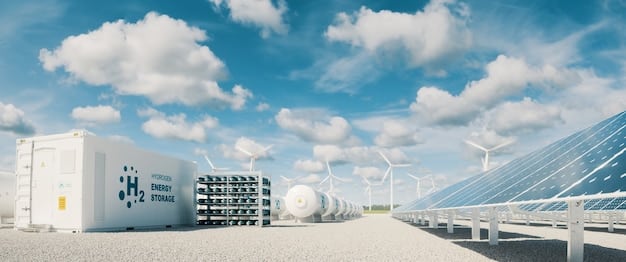Renewable Energy Storage: Overcoming Intermittency Challenges

Renewable energy storage is crucial for addressing the intermittency of sources like solar and wind, utilizing technologies such as batteries, pumped hydro, and thermal storage to ensure a consistent and reliable energy supply that overcomes fluctuations in renewable energy generation.
The shift to renewable energy sources is vital for a sustainable future, but harnessing the full potential of solar, wind, and hydro power hinges on effective energy storage. The science of renewable energy storage: how can we overcome the challenges of intermittency? is a question that demands innovative solutions and a deeper understanding of the technologies involved.
Understanding the Intermittency Challenge
Renewable energy sources such as solar and wind power are inherently intermittent. Solar power depends on sunlight, which varies with the time of day and weather conditions, while wind power depends on wind speed, which is also unpredictable. This intermittency poses a significant challenge to grid stability and reliability, making energy storage crucial for ensuring a consistent power supply.
The Nature of Intermittent Resources
The sporadic nature of solar and wind energy necessitates careful planning and innovative solutions. Unlike traditional power plants that can operate continuously, renewable sources fluctuate, leading to imbalances between supply and demand.
Impacts on Grid Stability
Integrating intermittent renewable energy sources into the grid can cause voltage fluctuations and frequency deviations. These disruptions can affect the performance of electrical equipment and even lead to blackouts if not properly managed.
- Maintaining a stable grid requires a balance between electricity supply and demand.
- Intermittency can lead to oversupply during peak renewable energy production and undersupply during low production periods.
- Energy storage systems help bridge the gap between supply and demand, ensuring a reliable power supply.
Addressing the intermittency challenge is essential for the widespread adoption of renewable energy. Effective energy storage solutions are needed to smooth out fluctuations, enhance grid stability, and reduce reliance on fossil fuels. The development and deployment of these solutions are crucial steps toward a sustainable energy future.
Battery Storage Technologies
Battery storage systems are a leading solution for addressing the intermittency challenge. These systems store excess energy generated during periods of high renewable energy production and release it when demand exceeds supply. Various battery technologies offer different advantages in terms of energy density, cost, and lifespan.

Lithium-Ion Batteries
Lithium-ion batteries are widely used in energy storage due to their high energy density and relatively long lifespan. They are commonly found in electric vehicles and grid-scale storage systems.
Flow Batteries
Flow batteries offer the advantage of scalability and long cycle life. They store energy in liquid electrolytes, allowing for independent scaling of energy and power capacity.
- Lithium-ion batteries have high energy density but can be more expensive.
- Flow batteries are ideal for long-duration storage but have lower energy density.
- Solid-state batteries are an emerging technology with the potential for higher energy density and improved safety.
Battery storage technologies are continually evolving, with ongoing research focused on improving performance, reducing costs, and enhancing safety. As battery technologies advance, they will play an increasingly important role in supporting the integration of renewable energy into the grid.
Pumped Hydro Storage
Pumped hydro storage (PHS) is one of the oldest and most widely used forms of energy storage. It involves pumping water from a lower reservoir to a higher reservoir during periods of low demand or excess energy production and releasing the water back down to generate electricity when demand is high. Pumped hydro storage systems are large-scale and can provide significant storage capacity.
How Pumped Hydro Works
PHS systems use surplus electricity to pump water uphill, storing it as potential energy. When electricity is needed, the water is released through turbines, generating power.
Advantages and Limitations
While PHS is effective and reliable, it has limitations in terms of geographical requirements and environmental impact. Sites need to have suitable elevation differences and water availability.

- PHS offers long-duration storage, making it suitable for balancing daily and weekly fluctuations in energy demand.
- The construction of PHS facilities can have significant environmental impacts, including habitat disruption and altered water flow.
- PHS is a mature technology with well-established operational practices.
Despite its limitations, PHS remains a valuable energy storage solution, particularly for regions with suitable topography. Ongoing efforts are focused on mitigating environmental impacts and improving the efficiency of PHS systems.
Thermal Energy Storage
Thermal energy storage (TES) involves storing energy in the form of heat or cold. This can be achieved through various methods, including storing hot water, molten salts, or ice. Thermal energy storage is particularly useful for applications such as heating, cooling, and power generation.
Methods of Thermal Storage
TES systems can store energy for later use in heating, cooling, or electricity generation. Different methods include sensible heat storage, latent heat storage, and thermochemical storage.
Applications and Benefits
TES is used in district heating and cooling systems, solar thermal power plants, and industrial processes to improve energy efficiency and reduce costs.
- TES can improve the efficiency of combined heat and power (CHP) systems.
- It is used in solar thermal power plants to store heat for electricity generation during periods of low sunlight.
- TES can reduce peak electricity demand and lower energy costs.
Thermal energy storage technologies are continually being refined, with research focused on developing more efficient and cost-effective storage materials and systems. As TES technologies advance, they will play an increasingly important role in supporting sustainable energy solutions.
Emerging Storage Technologies
In addition to the established storage technologies, several emerging technologies show promise for addressing the intermittency challenge. These include compressed air energy storage (CAES), liquid air energy storage (LAES), and hydrogen storage. Emerging storage technologies offer potential advantages in terms of scalability, cost, and environmental impact.
Compressed Air Energy Storage (CAES)
CAES involves compressing air and storing it in underground caverns or tanks. When energy is needed, the compressed air is released to drive turbines and generate electricity.
Liquid Air Energy Storage (LAES)
LAES involves cooling air to a liquid state and storing it in insulated tanks. When energy is needed, the liquid air is vaporized and used to drive turbines.
- CAES can provide large-scale energy storage but requires suitable geological formations.
- LAES offers the potential for high energy density and can be located independently of geological constraints.
- Hydrogen storage involves storing hydrogen produced from renewable sources for later use in fuel cells or combustion turbines.
These emerging storage technologies are still in the early stages of development, but they offer potential pathways to significantly improve energy storage capabilities. Ongoing research and pilot projects are essential for validating their performance and cost-effectiveness.
Policy and Economic Considerations
The widespread adoption of renewable energy storage requires supportive policies and economic incentives. Governments can play a crucial role in promoting the development and deployment of storage technologies through policies such as tax credits, subsidies, and mandates. Policy and economic considerations are essential for creating a favorable market environment for energy storage.
Government Incentives and Regulations
Government incentives can reduce the upfront costs of energy storage systems, making them more economically viable. Regulations can also mandate the use of energy storage to enhance grid stability and reliability.
Market Mechanisms
Market mechanisms such as time-of-use pricing and demand response programs can incentivize energy storage by providing economic signals that reflect the value of energy storage services.
- Tax credits and subsidies can help offset the high capital costs of energy storage systems.
- Mandates can require utilities to incorporate energy storage into their grid planning.
- Market mechanisms can create revenue streams for energy storage providers.
Effective policies and market mechanisms are needed to unlock the full potential of energy storage and support the transition to a sustainable energy future. Collaboration between governments, industry, and research institutions is essential for driving innovation and reducing costs.
| Key Point | Brief Description |
|---|---|
| 💡 Intermittency Challenge | Renewable sources fluctuate, causing grid instability. |
| 🔋 Battery Storage | Lithium-ion and flow batteries store excess energy. |
| 💧 Pumped Hydro | Pumps water uphill to store potential energy. |
| 🔥 Thermal Storage | Stores energy as heat or cold for later use. |
FAQ
▼
The primary challenge is their intermittency. Solar depends on sunlight, and wind depends on wind speed, both of which fluctuate and make consistent energy supply difficult.
▼
Battery storage systems store excess energy generated during periods of high renewable energy production. They release this energy when demand is high but renewable production is low.
▼
Pumped hydro offers long-duration storage, making it suitable for balancing daily and weekly fluctuations in energy demand. It’s also a mature and reliable technology.
▼
Thermal energy storage involves storing energy in the form of heat or cold. This stored energy can be used later for heating, cooling, or even electricity generation.
▼
Government policies, such as tax credits, subsidies, and mandates, can significantly incentivize the development and deployment of energy storage technologies. They create a favorable market.
Conclusion
The science of renewable energy storage is critical for overcoming the challenges of intermittency and enabling a sustainable energy future. By leveraging a combination of battery storage, pumped hydro, thermal storage, and emerging technologies, we can ensure a reliable and resilient energy supply that harnesses the full potential of renewable resources.





